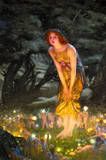


US researchers find 18th-century British warships
 US researchers find 18th-century British warships
US researchers find 18th-century British warships
By Richard C. Lewis ~Reuters
NEWPORT, Rhode Island (Reuters) - Four ships from a British fleet used during the U.S. Revolutionary War have been found off Rhode Island, and one may be the vessel 18th century explorer Captain James Cook sailed on his epic voyage to Australia, archaeologists said on Tuesday.
Researchers with the Rhode Island Marine Archaeology Project said they believe the four ships, and two others previously discovered, are part of a 13-vessel transport fleet intentionally sunk by the British in Newport Harbor in 1778 to keep French ships from landing to aid the Americans' drive for independence.
Using historical materials and sonar, the archaeologists discovered the ships in Narragansett Bay, within a mile (km) of Newport, Rhode Island's shoreline.
Divers found ballast piles about 30 feet underwater, with the ship's keel and other parts embedded in the sea floor. They also found at least one cannon, an anchor with a 16-foot (4.9-meter) shank and a cream-colored fragment of an 18th-century British ceramic teapot.
According to the team of archaeologists, one of the 13 ships in the sunken British fleet was the "Lord Sandwich," which records show was once the Endeavour, the vessel Cook used to sail the Pacific Ocean, map New Zealand and survey the eastern coast of Australia in 1768-1771.
Cook, acknowledged by historians as one of the greatest navigators of all time
is credited with surveying Australia's east coast on the Endeavour expedition.
Archaeologists said it was unclear which ship could be the Endeavour. Seven of the ships in the British fleet have not been found. But they said the latest find raises the chances that one of the discovered ships is the Endeavour.
"There is a 47 percent chance that we have our hands on the Endeavour," said D.K. Abbass, executive director of the Rhode Island Marine Archaeology Project, a nonprofit organization devoted to studying the state's maritime history.
She added it was unlikely anything on the ships would provide a direct link to Cook.
Historically, the finding is significant because it helps tell the story of the siege of Newport, marking France's first attempt to aid the American insurrection against the British.
Though the effort failed, leaders from each side, George Washington representing the Americans and Comte de Rochambeau for America's French allies, met in Newport two years later, to formalize their cooperation for subsequent battles.
The French ultimately helped the Americans entrap British forces on a peninsula at Yorktown, Virginia.
"So, what you have here is the British are geared up for the colonial rebellion and now they're looking at an international conflict," said Rod Mather, a British citizen and associate professor of maritime history and underwater archaeology at the University of Rhode Island.
The shipwrecks are Rhode Island property, Abbass said. There are no plans to raise them. Officials estimate more than two dozen ships from the Revolutionary War period lie beneath Rhode Island's waters. They include British Royal Navy frigates, vessels from the Continental Navy and a French ship.
The Faerie Zine, Issue Vol. 4 International Orders $19.95
 My first published Children's Book: STAR AND THE MILKY WAY CAFE, By Lisa Kettell
Queen-Lisas-Art-World
Moonfaires Etsy Store
My first published Children's Book: STAR AND THE MILKY WAY CAFE, By Lisa Kettell
Queen-Lisas-Art-World
Moonfaires Etsy Store

Theadora By Lisa Kettell aka Moonfaires
 CaPTuReD FaiRy:"ThE BLuE FaiRy"
Faerie Enchantment
Moonfaires World Website
CaPTuReD FaiRy:"ThE BLuE FaiRy"
Faerie Enchantment
Moonfaires World Website
 Me, with my art, at The Halloween Opera in Jim Thorpe, PA
Halloween Opera
Patient Creatures
Me, with my art, at The Halloween Opera in Jim Thorpe, PA
Halloween Opera
Patient Creatures
 Witches Worlds Fair by Lisa Kettell, This piece has been published in THE WINTER 2005-06 issue of ARTITUDE ZINE
Artitude Zine
Art Cards
ZneArt VariaZione
Spirito Di Zne
Bly-Me,Doll Blog
ZNE Dolls
ZNE Poetry
art-is-you
art-e-zine
Witches Worlds Fair by Lisa Kettell, This piece has been published in THE WINTER 2005-06 issue of ARTITUDE ZINE
Artitude Zine
Art Cards
ZneArt VariaZione
Spirito Di Zne
Bly-Me,Doll Blog
ZNE Dolls
ZNE Poetry
art-is-you
art-e-zine
 WiZaRd'S PLaY By Me!
WiZaRd'S PLaY By Me!
 My friend Crista, As, THe GaRdEn FAiRy
Crista Orefice Music
Alexandria Lanier
Alexandra Hull
Alice Lands
Altered Art by Karyn Gartel
AnastasiaC Blogspot
Anne Bulles Dorees
Art and Alchemy
Art and Ellen
Art and Ghosts
Art’s By Tini
Art Creations by Svenja
Artsy Mama
Artful Adventures by Sue Pieper
Art of Vera Lucia Emerim
art pfunk central
Artwerx
Be Witched Magic
Beyond The Vintage Path
Bohemiart
Capolan
Caryls Realm
Cherry and the Magic Garden
Cookala's House of Cards
CottageBubbles etsy
Couture de papier
Cryptia's Shoppe
Cupcake Kids Decor
Fairy Princess Designs
The Curiosities
Danita's Art
Darlene Schaper
DeBriNa PrAtt, SpArk YoUr ImAgiNatiOn
Debrina Pratt Blog
Designing Fairy Blog
Designing Fairy Website
Dirty Roses
Dirty Roses Blog
Doll Face Design
Dymphiem's Papier En Avonturen
e.beck.artist
enamor_etsy
Faerie Luna
Fairy Web Mother
Faerie Window
Flea Market Studio
Gabriela Delworth
Garden of Pink Shadows
Gilflings Designs
Goddess Of Hell Fire
goodygoodygumdrops.etsy
Gramarye's Dragon Fragments
Gypsy Adventure
Gypsy Purple
Gypsy Purple's Flickr Gallery
Holly Loves Art
HopHopJingleBoo
Insall Studios
Paulette Insall Blog
Izabella's Typepad
Velvet and Rust
Jacquis Closet
Jenny Holiday
Judy Scott
Junque Revival
Jupiter Designs
Karen Harvey Cox
Karen Jinks
Little Melfie
My friend Crista, As, THe GaRdEn FAiRy
Crista Orefice Music
Alexandria Lanier
Alexandra Hull
Alice Lands
Altered Art by Karyn Gartel
AnastasiaC Blogspot
Anne Bulles Dorees
Art and Alchemy
Art and Ellen
Art and Ghosts
Art’s By Tini
Art Creations by Svenja
Artsy Mama
Artful Adventures by Sue Pieper
Art of Vera Lucia Emerim
art pfunk central
Artwerx
Be Witched Magic
Beyond The Vintage Path
Bohemiart
Capolan
Caryls Realm
Cherry and the Magic Garden
Cookala's House of Cards
CottageBubbles etsy
Couture de papier
Cryptia's Shoppe
Cupcake Kids Decor
Fairy Princess Designs
The Curiosities
Danita's Art
Darlene Schaper
DeBriNa PrAtt, SpArk YoUr ImAgiNatiOn
Debrina Pratt Blog
Designing Fairy Blog
Designing Fairy Website
Dirty Roses
Dirty Roses Blog
Doll Face Design
Dymphiem's Papier En Avonturen
e.beck.artist
enamor_etsy
Faerie Luna
Fairy Web Mother
Faerie Window
Flea Market Studio
Gabriela Delworth
Garden of Pink Shadows
Gilflings Designs
Goddess Of Hell Fire
goodygoodygumdrops.etsy
Gramarye's Dragon Fragments
Gypsy Adventure
Gypsy Purple
Gypsy Purple's Flickr Gallery
Holly Loves Art
HopHopJingleBoo
Insall Studios
Paulette Insall Blog
Izabella's Typepad
Velvet and Rust
Jacquis Closet
Jenny Holiday
Judy Scott
Junque Revival
Jupiter Designs
Karen Harvey Cox
Karen Jinks
Little Melfie
Little Pink Studio
Little Things
Lola Enchanted
Loona's World by Sanja
Lora Jeans Magazine
Lucrecerb's Life Is The Heart
Mainer At Heart
The Magic of Mc Miscellany's
Marlas Faery Tails
Michelle Studio Art
Michelle Ward
Natasha May Designs
NotablyGifted Etsy
Oolagirl’s Images
Out On A Whim Studio
Out On A Whim Studio's Etsy Shop
Paintings By Sarah
Pam Garrison
Playing With Brushes Images
Polka Dot Pixie
Pretty Little Pendant Etsy
Rosalie Ackerson
Rowan Devoe
Ruffings Amazing Art
Sally Jean
Sandy's Creations
Sepia Art Studio
Shabby Arts
Shabby Pink Cottage Images
Something Two Crow About
Sophie The Pearl
Susan Tuttle
Susie Scott Studios
Sweet Candy Creations
Sweet Remembrance
Sweet Remembrance-Flea Market Queen
Sweet Pea Illustrations
TararossStudios
Tartx
The Tattered Circus
Teesha Moore
Tracy Roos
Art Propensity-Patricia Anders
Tricia Scott
 VinTaGe FaeRiE
VinTaGe FaeRiE
Vivs-Whimsy
Vintage Threads
Whim and Fancy Designs
Winemakerssister etsy
Woodwitch45
Xelas Kreativ Blog
VinTaGe FaeRiE
VinTaGe FaeRiE
Vivs-Whimsy
Vintage Threads
Whim and Fancy Designs
Winemakerssister etsy
Woodwitch45
Xelas Kreativ Blog
My FAvOriTe OdDiTiEs aNd CuRiOsiTiEs LiNkS
An Ounce of Civet.com
Anthropologie
The Art of Linsay Blondeau/Stare Case
Dirty Roses
Halloween Artists
Jamie B Wolcott Artwork
Mystic Dreams and Gothic Faery Store
Pigeon In Our Parlour
Sur La Lune Fairytales
Tallulahs Vintage Images
Top Hat Design Works
UHAT Unique Halloween Art Treasures
UHAT Blog
Victorian Halloween
Vintage Faerie
Zombelina
 KerRy KaTe's OCtoBeR EfFiGiEs
October Effigies
KerRy KaTe's OCtoBeR EfFiGiEs
October Effigies
 MiSeRy'S CHiLdReN By KaThY OLiVaS
The Art of Kathy Olivas
The Artwork of Tina Imel
The Works of Marion Peck
Dresden Dolls
Faerie Chronicles
ThE LeWiS CaRRoLL SoCiEtY oF NoRtH AmeRiCA
ThE LeWiS CaRRoLL SoCiEtY UK
MiSeRy'S CHiLdReN By KaThY OLiVaS
The Art of Kathy Olivas
The Artwork of Tina Imel
The Works of Marion Peck
Dresden Dolls
Faerie Chronicles
ThE LeWiS CaRRoLL SoCiEtY oF NoRtH AmeRiCA
ThE LeWiS CaRRoLL SoCiEtY UK
 EdiTh LoRiNa and ALiCe LiddELL, PhOtO TaKeN By CaRRoLL
ShaKeSpEaRe BiRThPLaCe TrUsT
EdiTh LoRiNa and ALiCe LiddELL, PhOtO TaKeN By CaRRoLL
ShaKeSpEaRe BiRThPLaCe TrUsT
 PhoTo FrOm, ThE ShaKeSpEaRe BiRThPLaCe TrUsT
PhoTo FrOm, ThE ShaKeSpEaRe BiRThPLaCe TrUsT
 CoVeR oF FaeRiE MaGaZiNe
Faerie Magazine
CoVeR oF FaeRiE MaGaZiNe
Faerie Magazine
Curious Adventure Links
 OLdE SpEciMen PHoTo Of A BeLiEvEd MeRmAiD/MeRmAn
OLdE SpEciMen PHoTo Of A BeLiEvEd MeRmAiD/MeRmAn
 Mr. AnD Mrs.LoUiS BaiLeY AuDiGiEr, 1913 GrEaT SpHinX
Mr. AnD Mrs.LoUiS BaiLeY AuDiGiEr, 1913 GrEaT SpHinX
 HaTsHepSuT As KiNg, At ThE MeT
The Metropolitan Museum of Art
HaTsHepSuT As KiNg, At ThE MeT
The Metropolitan Museum of Art
 CaPe YoRk MeTeOriTeS aT AmNh
American Museum of Natural History, NYC
The World of Sake
CaPe YoRk MeTeOriTeS aT AmNh
American Museum of Natural History, NYC
The World of Sake
 InSiDe ThE SaKe BaR, DeCiBeL, 240 East 9th Street in NYC, 212-979-2733
InSiDe ThE SaKe BaR, DeCiBeL, 240 East 9th Street in NYC, 212-979-2733

 A PeAcOcK At WarWiCk CaStLe
HeArT oF EnGLaNd, VaRiOuS EnGLiSh AdVeNTuReS
SaLeM,Mass
SaLeM's HauNtEd HapPeniNgS
A PeAcOcK At WarWiCk CaStLe
HeArT oF EnGLaNd, VaRiOuS EnGLiSh AdVeNTuReS
SaLeM,Mass
SaLeM's HauNtEd HapPeniNgS
 HoCuS PoCuS
HoCuS PoCuS
 HeAdLesS HoRsEMaN oF MoOn HoLLoW by Me!
GeO CacHiNg
MonHeGaN IsLanD And BoaT LiNe
MaiNe LobStEr FeStiVaL
ThE BerRy MaNoR Inn
CaFe ArCheTyPuS
ReD SkY BaR NyC
BuSh KiLL FaLLs
HeAdLesS HoRsEMaN oF MoOn HoLLoW by Me!
GeO CacHiNg
MonHeGaN IsLanD And BoaT LiNe
MaiNe LobStEr FeStiVaL
ThE BerRy MaNoR Inn
CaFe ArCheTyPuS
ReD SkY BaR NyC
BuSh KiLL FaLLs
 SeRenDiPiTy, NYC
SeRenDiPiTy, NYC
SeRenDiPiTy, NYC
SeRenDiPiTy, NYC

CupCakEs ArE FaiRy SwEEt
CupCakE CaFe NYC
CaFe ECcLeCtiC, MonTcLaiR, NJ
CaFe ECcLeCtiC 2nD WebSiTe, MonTcLaiR, NJ
MoOnFaiReS FaVoRiTe MoVie Links And CuRioSiTieS
 A SCeNe FrOm PhAnToM Of ThE OpEra
PhAnToM oF ThE OpeRa
A SCeNe FrOm PhAnToM Of ThE OpEra
PhAnToM oF ThE OpeRa
 ELiZaBeTh McGraTh, EvErYThInG ThAt CrEePs
ELiZaBeTh McGraTh, EvErYThInG ThAt CrEePs






 The Faerie Zine Vol.4 $19.95
The Faerie Zine Vol.4 $19.95




























0 Comments:
Post a Comment
<< Home